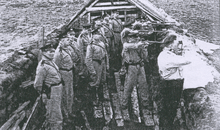Víkingasveitin
| Sérsveit Ríkislögreglustjóra | |
|---|---|
| Active | 19 October 1982 – present |
| Country |
|
| Type | Law enforcement |
| Role | Security of the state and state officials, Security of foreign dignitaries, Counter-Terrorism and Law Enforcement |
| Size | About 50 |
| Nickname | Víkingasveitin ("The Viking squad") |
| Motto | Með lögum skal land byggja ("The land shall be built by laws" Alternative translation: "With laws shall this country be established") |
Víkingasveitin (Icelandic pronunciation: [ˈviːkiŋkaˌsveitɪn], The Viking Squad), officially Sérsveit ríkislögreglustjórans (Special Unit of the National Police Commissioner), is Iceland's elite counter-terrorism unit, specializing in various types of armed and unarmed infantry combat. It is in many ways modeled on the Norwegian Emergency Response Unit counter-terrorist unit with which it conducts many exercises, both in Norway and Iceland. The Viking squad has about 50 police officers. The National Police Commissioner has published that the squad will be fully manned at 55 police officers by 2010. Iceland has no standing regular military, thus some functions performed by military forces in other nations may be performed in Iceland by units such as Víkingasveitin.
Duties
The unit is tasked with several duties, including but not limited to:
- Security of the state and state officials
- Security of foreign dignitaries
- Counter-terrorism
- Support of local police forces
Additionally, the unit is designated to protect important installations in wartime, and it is often involved in exercises with Norwegian and Danish military special forces. During the stay of the U.S. military forces in Iceland, it conducted anti-special forces training operations and was responsible for its defences against terrorism.
Squads
The Viking Squad has five main squads:
- Alpha Squad: A bomb squad specializing in bomb defusal.
- Bravo Squad: A boat squad specializing in operations on sea and water, diving and underwater warfare, and boat operations.
- Charlie Squad: A sniper squad specializing in sniper warfare, entries, and close target reconnaissance.
- Delta Squad: An intelligence squad specializing in anti-terrorism intelligence, surveillance, and infiltration.
- Echo Squad: An airborne squad specializing in aircraft hijacking operations, skydiving and surprise assault operations, along with port security.
History
Armed police

Although the first Icelandic law enforcement officers, the nightwatchmen of Reykjavík in the 18th century, were heavily armed with morningstars, the armed capabilities of early 20th century police were very limited. However the threat of a communist revolution and later invasion by foreign militaries forced the Icelandic government to rethink its position on police weaponry.
As a response to the forming of an illegal communist paramilitary unit the Icelandic police acquired Krag-Jørgensen rifles, Royal MM34 and Royal 7.65 mm pistols and in late 1939 officers of the Capital Police were to form the officer corps of an Icelandic military defence force. This rearming was spearheaded by Hermann Jónasson prime minister and former police chief and Agnar Kofoed Hansen Chief of Capital Police and Officer graduate from the Danish Army. This military force never went from the training grounds as it was still training on 10 May 1940, the day 740 Royal Marines invaded Iceland.
During the war Agnar did his best to continue acquiring weapons despite the unwillingness of British occupational forces to permit such imports. Nonetheless Reising cal 45. sub-machine guns and Federal laboratories grenade launchers were bought from the U.S. along with tear grenades.
The forming of a military defence force from the military trained portion of the Icelandic police didn't continue after the war, as it was eventually decided that the U.S. Armed Forces would continue to defend Iceland from military threats while Icelandic police concentrated on internal threats from communist revolutionary forces.
The Viking Squad
The Special Unit is considered to have been officially founded in 19 October 1982, when its first members finished training with Norwegian Special forces. There were many reasons for commissioning the unit, including a hijacked airliner that landed at Keflavík International Airport in 1976 and a few occasions of criminals using firearms against unarmed policemen. It had become clear that the Icelandic Police needed an effective tool to combat such violent, armed situations.
In December 2003, Minister of Justice, Björn Bjarnason, introduced plans to strengthen the unit in response to the War on Terrorism, and further its responsibility in all operational issues covering more than one local jurisdictions. Today, members of the unit are stationed in three different police districts, Höfuðborgarsvæðið police district (metropolitan police), Suðurnes police district and Akureyri police district.
On 2 December 2013, a man died after a gun battle with the force. The unit had never been in armed conflict before and the fatality is the first from police in Iceland.[1][2]
See also
- Icelandic National Police
- Military of Iceland
References
- ↑ "Rare Iceland armed police operation leaves man dead". BBC. 2 December 2013. Retrieved 4 December 2013.
- ↑ "Sérsveitin aldrei gripið til vopna". 2 December 2013. Retrieved 4 December 2013.
External links
| ||||||